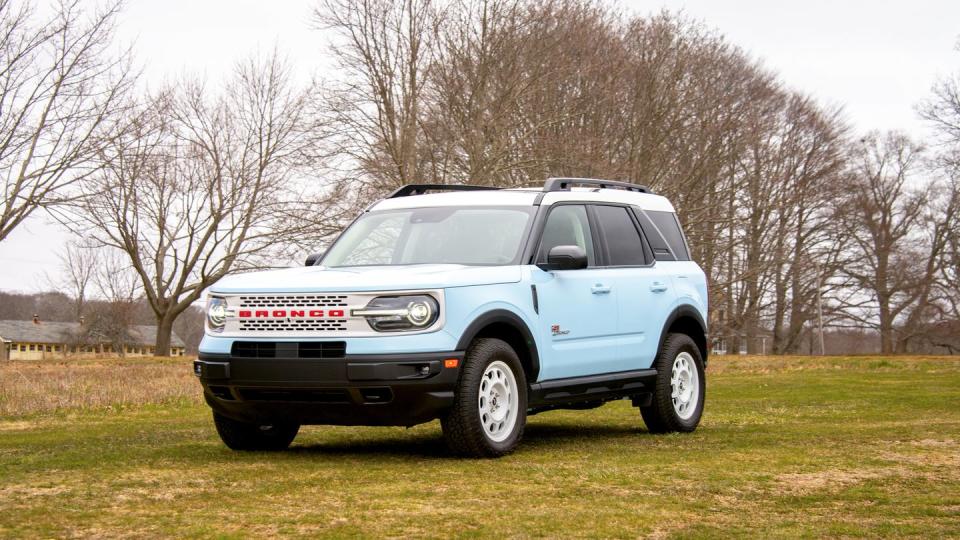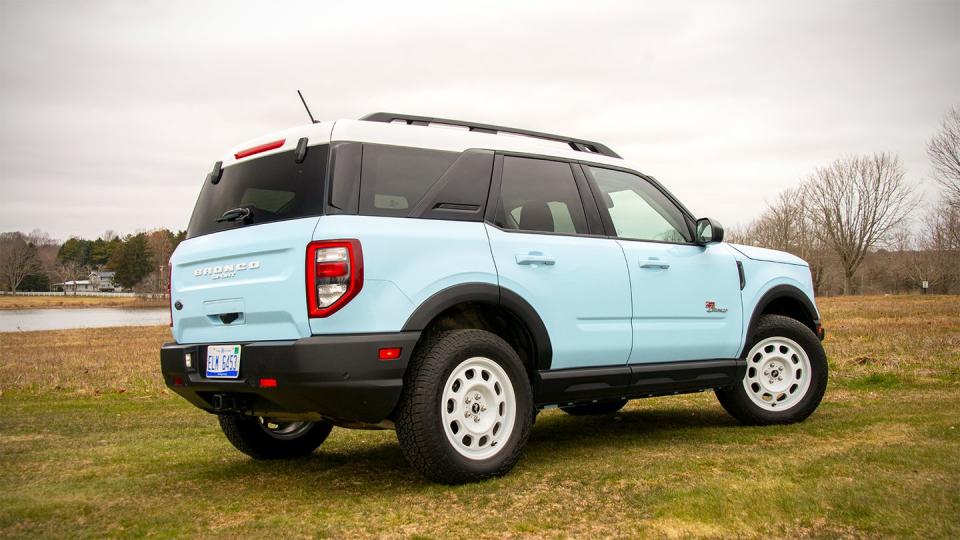Ford Bronco Sport Heritage Puts on Some Retro Duds

Ford Bronco Sport Heritage Limited 4x4 is powered by a turbocharged 2.0-liter inline-four with 250 hp and 277 lb-ft of torque on tap, paired with an eight-speed transmission, though a less powerful 1.5-liter three-cylinder engine is also on the menu with 181 hp and 190 lb-ft of torque.
The four-door model offers a tidy footprint, with just enough space inside for family adventures and for commuting, as well as enough off-road skills to offer a compelling alternative to small crossovers without compromising everyday usability.
The Heritage model is one of the more affordable trims in the Bronco Sport lineup, which features some variety but doesn't stretch too far north price-wise, with this version starting at $33,960 before additional options.
The return of the Ford Bronco in 2021 was overdue, with the Explorer having become a crossover long ago and with Ford having largely ceded the off-road market to Jeep. This niche has proven to be profitable for the latter, even as Ford busied itself in updating the Escape every few years, and it was becoming clear that Ford had been leaving plenty of money on the table at a time when burly SUVs of all sizes were showing no signs of becoming less popular. The success of the F-150 Raptor over the past decade only confirmed this.
The larger of the two Broncos is certainly a capable off-road machine. But it probably wasn't going to be the most commute-friendly SUV out there.
That's why in bringing back the Bronco a few years ago as a veritable trail machine, Ford also resurrected its smaller sibling, designed to feel just as nimble on forest trails as in the city. It would also allow Ford to take on Jeep's lineup from more than one direction, with pocket-sized SUVs having become a common family car long ago.
This is how the Bronco Sport returned as the spiritual successor to the Bronco II, offering a tidy footprint and most of the off-road skills of its big brother—a formula we hadn't seen since the early 1990s when the Bronco II inspired the original Explorer of 1991.
Now that the Bronco Sport is a few years old, does it still feel modern and useful?
That's what we wanted to find out when we spent a week in the retro-themed Bronco Sport Heritage Limited 4x4 that harkens back to the original Bronco's exterior design and color palette.

First, it's useful to recall just what the greater Bronco Sport lineup offers, as there are quite a few choices.
The base engine is a turbocharged 1.5-liter three-cylinder, good for 181 hp and 190 lb-ft of torque, paired with an eight-speed automatic. While this powertrain has generally been deemed to be capable enough for most daily tasks, making the run from 0 to 60 mph in just over 8 seconds, buyers also have the option of a turbocharged inline-four with 250 hp and 277 lb-ft of torque on tap paired with the same eight-speed transmission.
The latter unit cuts that sprint time down to 5.9 seconds, but more importantly it dials up the torque to permit some greater off-road excursions, which are still an important part of the whole package.
A total of five flavors are on the menu, starting with the base Big Bend trim, followed by our retro-themed Heritage, the '70s-stickered Free Wheeling, Outer Banks, and the range-topping Badlands trim. But it's a relatively narrow spectrum when it comes to price, with the base Big Bend model starting at $31,390, while the Badlands trim maxes out the off-road goodies and options with revised dampers and a lifted suspension with a starting price of $39,985.
As other trims, the Heritage model offers up the Bronco's terrain management system with five G.O.A.T. modes: Eco, Sport, Normal, Slippery, and Sand/Snow which automatically change the braking setup, steering feel, throttle behavior, and transmission shift points based on the selected terrain setting.
But before we get to an off-road course, we first have to drive there over something you're probably going to see on your commute: Pavement. And not just any pavement, but broken 21st-century standard-issue US pavement.
And it's where the Bronco Sport feels at ease without its off-road abilities intruding upon daily driving tasks. The steering feel is biased toward comfort, while the short wheelbase and tires with plenty of sidewall give the ride a responsive but not overly floaty quality. This allows the Bronco Sport to shrug off some serious potholes, while keeping its road manners in check.

On the highway, road noise is only moderate, with the 250-hp four-cylinder providing the small SUV with enough overtaking power. This is also where the Bronco Sport's eight-speed transmission proves to be an unobtrusive unit, settling into its comfort zone with few reminders of its operation.
The back roads are also where the small Bronco feels at home, and dialed into the Sport setting the engine responds well on some twisty, paved roads without seeming wheezy, and without forcing the transmission to be overly dramatic.
Once we've found a trail with some half-buried boulders doused with a recent rain, it's time to try out the Slippery mode. The Bronco slowly pulls us up the sandy trail, with the tires grabbing on to a few larger rocks covered with slick clay. And with a few throttle inputs the gravel starts rattling inside the wheel wells, as the Bronco progresses up the trail.
Once we've reached the top of the forested hill, a road covered with loose gravel lies ahead of us leading back down. This time, we'll try Sand mode in our slow descent, with this mode proving to be adept in letting the Bronco negotiate gravel. More importantly, the steering feel and the suspension give a good picture of what's underneath the vehicle.
Overall, the suspension is communicative enough even on off-road trails to let us know just which boulders are probably best left alone, and which ones can be handled with ease. It also lets us know which clay-filled puddle could require a deeper cleaning of the wheel arches and exterior afterward.

Speaking of the exterior, one favorite feature that we don't really see much in our current electric crossover dystopia is a separately opening rear glass window. The Bronco Sport offers that, plus a two-tiered parcel shelf system in the cargo area that's standard on the Heritage model and optional on Big Bend, complete with a rubber mat.
The interior is equally rugged, even though it's certainly worth it to get a set of rubber floor mats for all four passengers if you're going to be venturing where Wellington boots are mandatory. And the tan seats' zippered pockets will stow some of the smaller gear when exploring the trails.
Our Bronco Sport Heritage Limited 4x4 was optioned up to $46,400, but it's certainly possible to stick closer to the model's starting price of $33,960 and still drive away with a very complete SUV that hides its Ford Escape roots well.
On the outside, the Heritage trim finished in Robin's Egg Blue added a retro touch with Oxford White grille with red lettering, along with 17-inch phone-dial wheels and a roof finished in the same color, in addition to retro badging. It certainly made us, ahem, noticeable from afar in a parking lot filled with Landlord Gray crossovers, and it also made us remember a time when buyers would choose actual colors when optioning cars.
More importantly, we suspect that the Bronco Sport also lands in that rare sweet spot of being The Most Car many people will actually need every day, without straying into land-crushing excess, eye-watering depreciation of luxury models, anonymous grayness, or into debt.
Will we see significant interest in electric 4x4s of this size in this decade, or is demand mostly focused on internal combustion models in this segment? Let us know what you think in the comments.

 Yahoo Autos
Yahoo Autos 